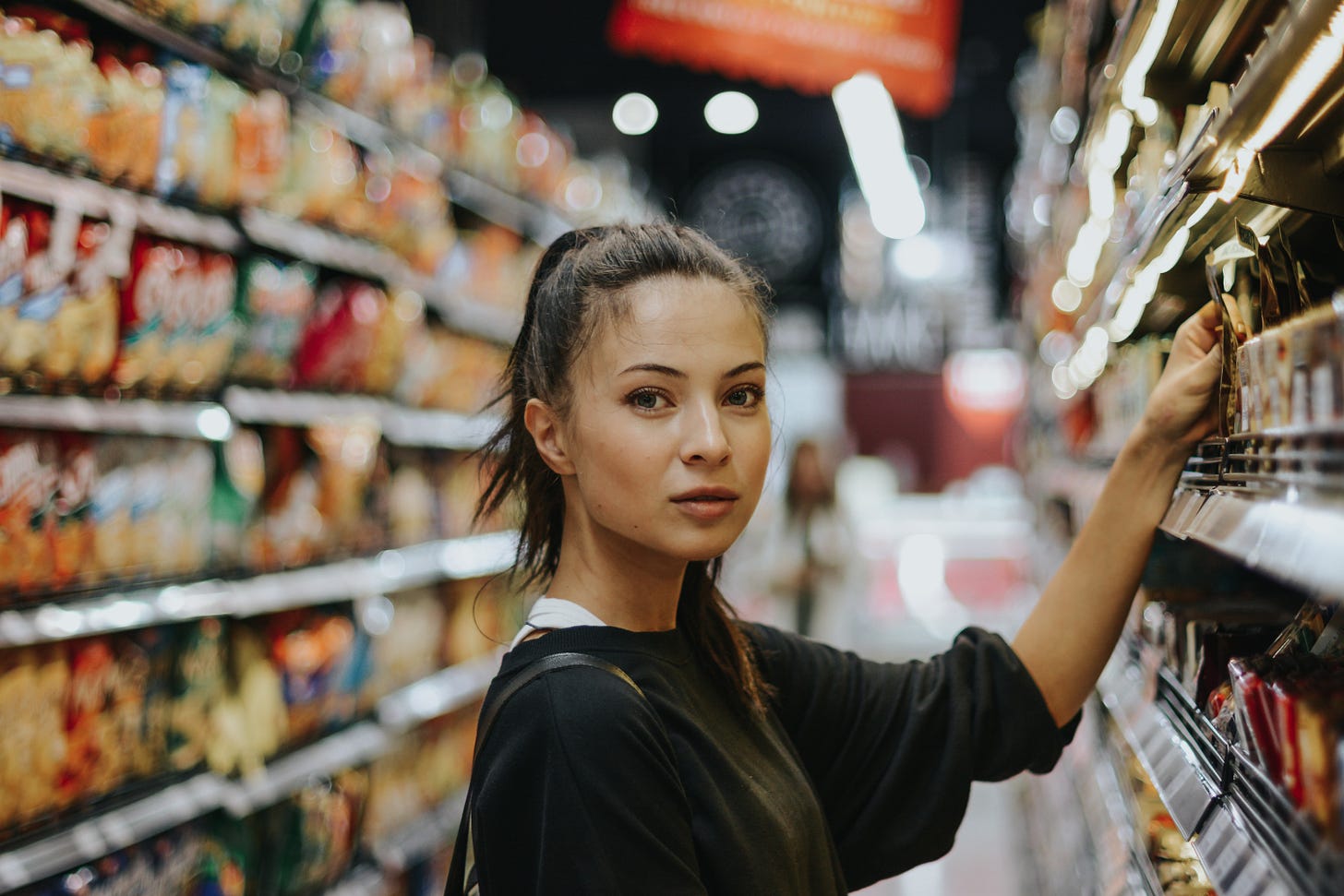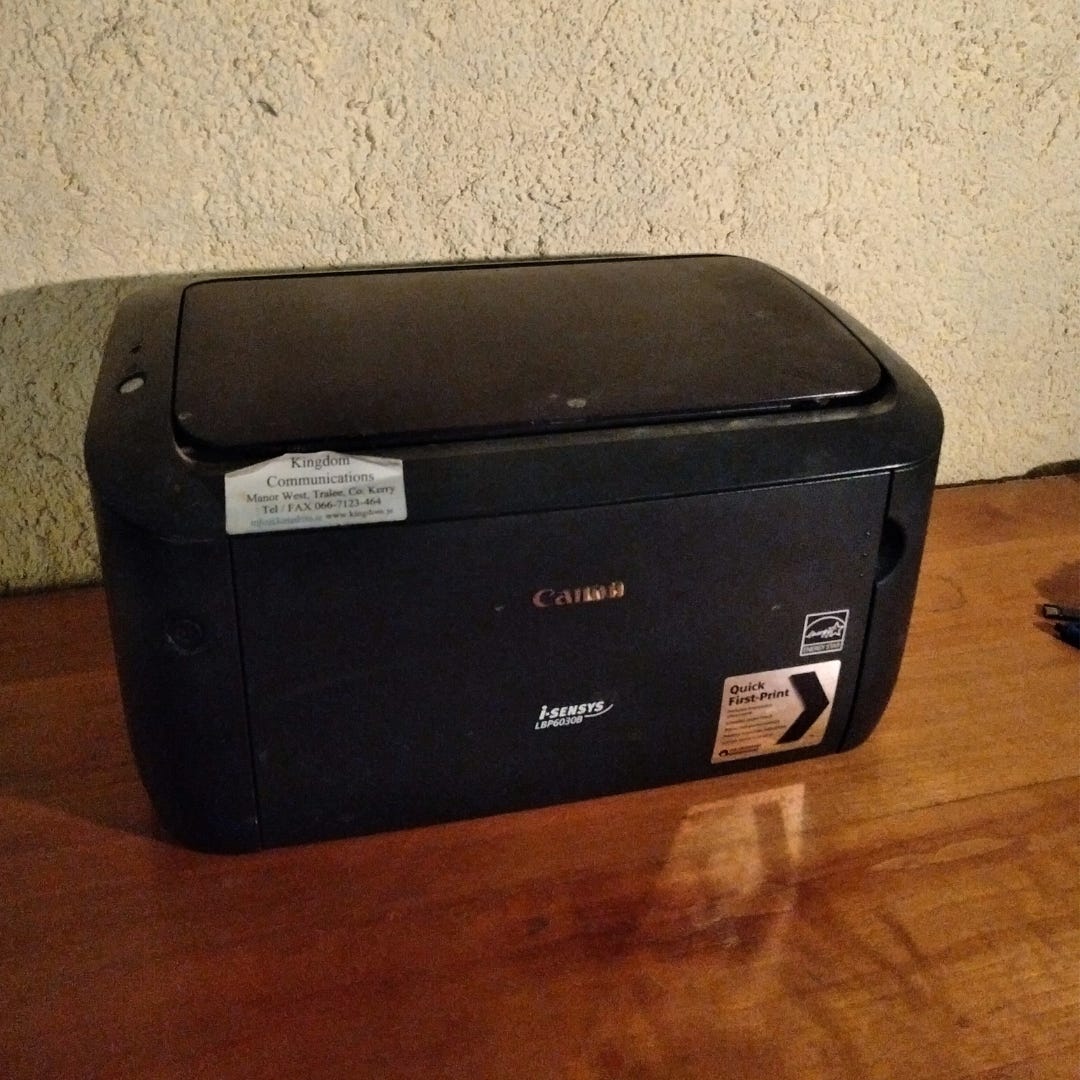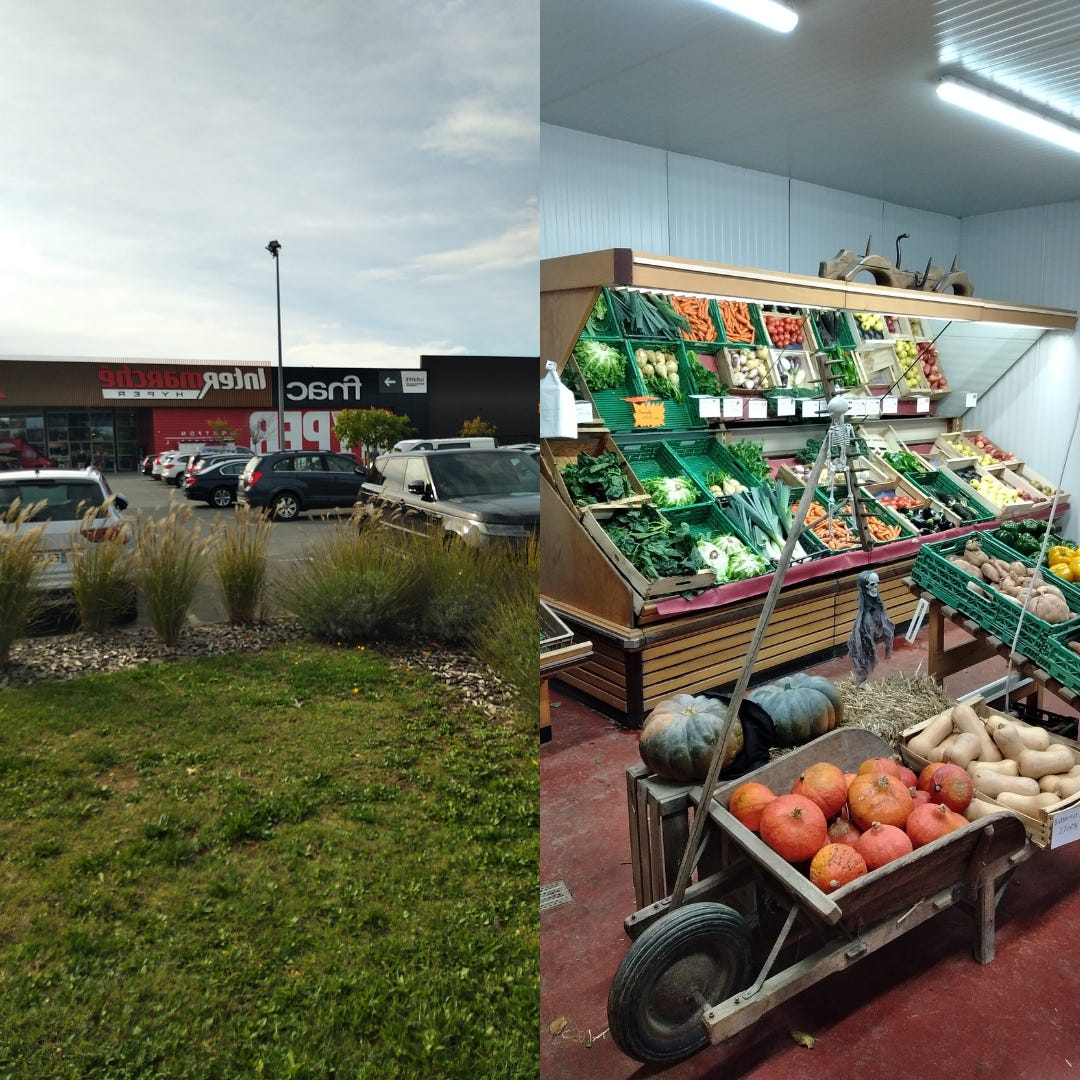Sustainable consumption is simple. Support the brands that are environmentally friendly. Avoid those that are not.
But there’s nothing easy about sustainable consumption. Just ask anyone who’s spent half an hour trying to choose between 3 brands of tomato sauce.
I’ve been a sustainable consumer for nearly 2 decades. Over that time, I’ve learnt to sort the green from the greenwashing by applying a series of questions to every purchase. Here are 8 questions that will help you do the same.

Sustainable consumers have all the power
If you’ve ever tried to buy sustainably, you’ve probably come up against the following objections:
Why plant a tree when rainforests are being torn down around the globe?
Why stop using weedkiller at home when farmers can still spray it on their land?
Why install solar panels when heavy industry still uses coal and nuclear?
These are all fair questions. But who’s buying the beef raised where the rainforests used to stand? Who’s buying the onions grown by the farmer spraying for weeds? Who’s buying the products manufactured by heavy industry? The answer is us, the consumers. (I know: not an easy pill to swallow.)
Remember that companies exist and operate to make profit. It’s what drives most of them to cut safety corners, underpay staff and degrade the environment.
So just for a moment, try taking the bull by the other horn. Perhaps we can’t control what companies do for profit. But we can control their profit.
If you buy it, they will sell it.
And if you don’t, they won’t. The market obeys the consumer, not the other way round.
Don’t believe me? Let’s dive into an example.
The rise and rise of electric cars
The IEA recently analysed the EV market and noted record figures for 2022. Sales were up 55% on 2021, and had climbed from 1 million to 10 million in just 5 years. There were also 60% more EVs on the road in 2022 than in 2021, and 5 times more than in 2018.
I remember a time when the words “electric car” would be met with snorts and eye-rolling. Now look where we are! What was once unthinkable is now basic, all in less than a decade. And that’s because people are buying electric cars.
If you buy it, they will sell it.
And if you don’t, they won’t
Have you noticed what’s happening to DVDs? According to Forbes, Disney is no longer shipping DVDs to Australia and New Zealand. In 2022, DVD sales dropped by nearly 20% relative to 2021. Even Netflix, which began as a video rental company, dropped its legacy rental service in September 2023.
Disney and Netflix are giants. Yet here they are, following the consumer.
What’s all this got to do with sustainable consumption?
Everything. If you want to see a more sustainable market, buy sustainable. If you’re tired of seeing the shelves stacked with environmentally dubious products and nefarious brands, don’t buy them.
It really is that simple. No matter how big the company or how obnoxious the CEO, they need your support.
So you see, we do have all the power. This is sustainable consumption. We drive sustainable change through our choices as consumers.
Is sustainable consumption that easy?
It certainly sounds easy. But try spending 25 minutes in a supermarket humming and hawing over 31 brands of shampoo. You’ll realise it’s not so easy in practice.
If you read my post about sustainability, you’ll know my history with shampoo, so let’s stick with shampoo for a moment. Say you’re looking for a sustainable brand, one that will have your hair looking fab without killing every living creature downstream of your shower drain. Here’s what you’re up against:
It may take time to decide whether a brand is sustainable
It may take more effort to source a sustainable brand than its mainsteam competitors
And it may cost more
Time, effort, money. Three obstacles to sustainable consumption.
Effort and money are easy to fix. The more you buy a product, the more available it becomes, and the more other people buy it. This in turn leads to greater economies of scale and cheaper prices.
Time is harder to fix. Because if you’ve ever tried to make a sustainable purchase, you’ll how just how flippin’ long it can take to decide whether a product is actually sustainable.
Luckily for you, I’ve been a sustainable consumer for 20 years. Use my checklist below to weed out the phoneys in a jiffy.
8 ways to sort the green from the greenwashing
This checklist might seem overwhelming at first. But use it once, use it twice, and it’ll become second nature in no time.
1. Need versus want
It starts here.
In the last 50 years, advertising and a relative absence of hardship have blurred the line between needs and wants.
“Daddy, I need a new phone!”
“I need a PlayStation! All my friends have one!”
“I need a new suit! All my jackets are out of fashion.”
You need? Really?
Okay, according to Maslow’s Hierarchy of Needs, the phone, the PlayStation and the suit may fulfil our need for respect or status. Technically, you can need a PlayStation. You can need new clothes.
But before you hit the shops, remember that in Maslow’s hierarchy, respect and status come after basic physical needs, safety, and love and belonging. So needs they may be, but hardly vital.
Remember too that overconsumption is one of the primary threats to our existence on this planet. Needs like respect and status may matter, but not more than survival.
This is the most important question to consider as a sustainable consumer. Do you truly need what you’re buying? Do you need it to survive or to be liked? Which comes first? Because that’s what we’re talking about: live sustainably or die.
2. Business as usual?
When you’re weighing up a brand or a product, do you get the feeling it’s saying “Psst, don’t stress! Just buy me instead of the other bozo.” This is business as usual. It doesn’t matter how net-zero a product is. If we keep buying like there’s no tomorrow, we’re in trouble.
Business as usual guides most governments’ environmental policies. It pokes its head out from behind plenty of clean tech too.
Not sure what I’m on about? Look at Apple’s corporate sustainability ad (in which they shamelessly plug their new sustainable watches). Enticing people to buy new a watch when they probably already have one is, for me, business as usual. It’s consumer culture with a make-over. It drives climate change. (And it drives me nuts, as I explain in this LinkedIn post about Apple’s so-called sustainability.)
3. New versus repair?
Ever tried to fix a household appliance only to be told “Yerra, just buy a new one – it’ll cost an arm and a leg to repair.”
Ever heard of programmed obsolescence?
Companies mostly don’t want you to repair products. They want you to buy them again. And so they make repairs unaffordable and design products that catastrophically fail after a set period of time.
Yet not everyone is duped. Here, there and everywhere, people are turning their backs on the false dichotomy of buy new or pay more to repair. Look out for words like circular, thrift, refurbished and reconditioned. From household appliances to computers and phones to bicycles and clothes, enterprises are keeping resources out of the dump and in use.
And as a sustainable consumer, it’s your job to support them.
4. How long will it last?
I once went to my IT guy and said “Give me a printer that won’t die!” He beamed a smile at me, rubbing his hands as if to say “Finally!”
This is the printer he gave me.

A little scruffy perhaps, but still working like a dream despite being nearly 10 years old – that’s 96 in human years!
When my IT guy and I were weighing up our options, the core requirement – longevity – shaped our choice of printer in unexpected ways:
Black and white only
Single-function
Laser
The result was a much simpler printer mechanically. More robust and, should the need arise, easier to fix.
Try approaching your next purchase with longevity in mind. You might be surprised where it leads you.
5. How far away is it?
Irish apples are delicious. We have just enough sunshine for them to ripen and plenty of rain to keep them watered. We also have little heavy industry, so growing them organically should be a cinch.
Imagine my deep sigh when I go to a local Irish shop in prime apple season – autumn – and can’t find a single organic Irish apple. The closest alternatives come from France. The 1,500 km those French apples travel undoes all the good of growing them organically. Besides, where’s my money going? Not back into my community.
So yes, organic is good. But sometimes, local is better. Cheaper too.
6. Where does it come from, if it must come from afar?
When Russia invaded Ukraine, the EU decided to stop buying its gas from Russia. About time, you might say. Gas is hardly a solution for the future anyway. And no one felt comfortable lining Putin’s pockets, however indirectly.
(On a side note, the EU’s new suppliers are Israel and Egypt. Can anyone explain to me how these two human rights abusers are preferable to Russia?)
Why should geopolitics matter to us as sustainable consumers? We are tearing down forests to graze cattle, forcing children down mines to make smart phones, and waging wars to secure oil. So the next time you order a burger, buy a new phone or fill up your car, consider this: given what’s happening in faraway countries to bring this product all the way to you, do you really need it?
7. What happens when you’re finished with it?
Every single item on every shelf in every shop will one day be discarded. So whenever you buy a product, no matter how trivial, remember that the item you hold in your hands will be waste. Now ask yourself 2 questions:
Do you need it? (Yes, we’re back to the core question.)
If you must buy it, what happens after you’re finished with it?
I can think of 6 outcomes. Whenever possible, stay away from the bottom of this list.
Composting returns resources to the soil. If an item must be discarded, compost it if you can.
Upcycling keeps an item out of waste by giving it a new purpose and is only limited by our imagination.
Recycling is better than some options on this list but still requires energy and resources.
Incineration can be useful, like the waste-to-energy incinerator in Dublin. Or it can be as basic as open burning in developing countries.
Landfill is humanity’s traditional form of waste disposal. The philosophy is out of sight = out of mind. Unfortunately for us, out of mind ≠ out of trouble.
Illegal dumping is even worse than a landfill. Can you guess what happens when our waste ends up all the way down near Antarctica? Check out the clip below.
8. Where are the profits going?
When you buy a product, sustainable or not, you’re giving your money to someone. It might be a friend, a small business owner – or a wealthy shareholder who invests your money in oil and gas operations in the Bering Sea.
That my money might make a wealthy person even wealthier from a sector as dirty and corrupt as oil and gas brings bile into my throat.
Here’s a real world example. On the left is a well-known supermarket near my home. On the right is a small independent shop where local farmers and businesses sell their goods.
When I spend my money in the local shop, I know who it’s going to and where it’ll be spent – in the community.
Can we say the same of the supermarket’s shareholders? Can we even know who they are?





Great list of questions to consider, said the member of the choir. :^) I also really like your quote "If you buy it, they will sell it". To the "Do you need it?" discussion I'd add - Before you buy any non-essential item, try waiting a week before you make the purchase. For me, at any rate, these needs and wants often fade away and this way the bank balance grows too.